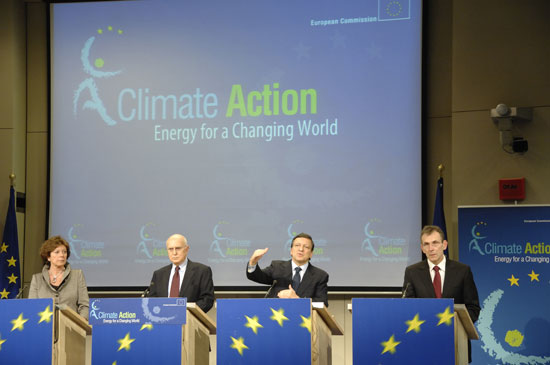
Yesterday the European Union agreed on a plan of action against climate change. The aim is a 20% cut in greenhouse gas emissions by 2020 from the European countries. But the aim could be increased to 30% if other countries follow suite.
To be able to reach the 20% cuts in greenhouse gas emissions by year 2020 the European Commission have outlined four measures that will help them achieve the goal:
- An improved emissions trading system (ETS) is needed. The new improved trading system will cover more emissions and allow companies in one EU country to buy allowances in any other.
- Emission reduction targets for industries not covered by the ETS, so that everyone can contribute. Examples on industries not covered are buildings, transport, waste etc.
- Legally binding targets will be introduced for increasing the share of renewable energy in every country. The different targets will reflect each countries individual potential.
- And finally new rules on carbon capture and storage and on environmental subsidies will be introduced throughout the EU.
The whole plan is expected to cost 3 euros a week for every citizen (60 billion euros a year). The European Commission President Jose Manuel Barroso says the cost is “manageableâ€.
Yesterday at the press conference where EU's plan of action was presented, Jose Manuel Barroso said that:
With this plan of action the EU is aiming to stopping the global temperatures to rise above 2 degrees. But is the plan enough? Many people think not.
Unfortunately a 20% decrease in greenhouse gas emissions is not enough to stop climate change running out of control. If you listen to the scientists a 2 degree increase in global temperature is not enough to stop the worst effects of climate change. Only aiming for 20% cuts will take us to a 3 degrees increase in global temperatures where climate change will run out of control and there will be no turning back.
Last time the earth were 3 degrees hotter than it is today the North Pole and Greenland were ice free, trees were growing in Antarctic and the sea level was 25 metres higher than it is today.
According to CarbonEquity we should, "if we value biodiversity and human life", instead aim for a 0,5 degree (320 ppm CO2e) target. In a recent paper, CarbonEquity explains why we should aim for 0,5 degrees and explains that it is possible with global and massive political actions.
Video: "Taking a head start to create a low carbon world economy"
abWritePlayer(1664375, 468, 400, "http://vid.adbrite.com/video/abplayer?");
Image and Video credit: European Communities.

Recommended Comments
Join the conversation
You can post now and register later. If you have an account, sign in now to post with your account.